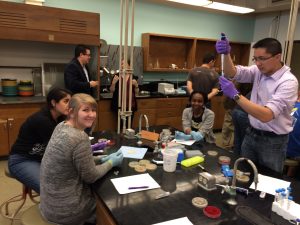(this post was written by group #2 as a writing assignment)

The goal of this week experiment was to extract genomic DNA from our samples for sequencing. Ultimately, we want to characterize the DNA from samples by sequencing them. However, since our isolates are in small amounts, we need to do an additional step (in next session) which is called PCR. In PCR we amplify smaller pieces of the DNA to create multiple copies of particular sequences and therefore larger amounts of DNA. This step will be particularly important since larger amounts of DNA will lead to more accurate and reliable results.
Isolating DNA from liquid bacterial cultures was fascinating. There were three main steps in this process; loading, washing and elution which we explain briefly below.
At first, we used centrifuge to condense the bacterial cells into a pellet and we then pipet out the nutrient broth. We now needed to lyse the cells to release the contents so we added some buffers. Ethanol was also added to precipitate the DNA molecules. Adding Ethanol disrupts the charge shielding and thus in the second centrifuge when the solution is passed through the silica column, it allows the DNA to stick to it. Next in the washing step, we removed any compounds that are not DNA while the DNA still sticks to the column. In the elution step, we used a solution that releases the DNA from the spin column, so that the only compound in the solution that we keep is DNA.
While DNA extraction was a lot of fun, there were some challenges as well. For instance, there were not enough pipettes (only one pipette was assigned to each team) and thus when a step of the process required that pipette, everyone in the group had to wait for a person to finish pipetting before they could move on. Also, It was more time consuming than we expected since we only had 1 tube rack that we had to keep passing around. Overall, most of the challenges were due to lack of instruments.
Lastly, I would like to point out that our group includes students with a wide range of background; some had never used a pipette before while others have previous trainings from working in the lab. It is an amazing experience to work together in a lab setting and learn from our mistakes. The important part is that this class is teaching everyone something, and it’s not difficult, which is how learning should be.
Comments:
The first centrifuge is to condense the bacterial cells into a pellet. We pipet out the nutrient broth.
Proteinase K is added to lyse the cells, or to break them open and release the contents. The buffers added during this step are to provide conditions (pH, salts) to maximize enzyme activity. The incubation step is performed at the optimal temperature for the enzyme to work. Ethanol is added to precipitate the DNA molecules. The way this works is that normally, the negatively charged phosphate backbone of DNA is shielded by the water molecules. Note that the buffer solution also contains positive ions such as sodium. Adding ethanol disrupts the charge shielding, allowing the positive ions to bind both to the negative phosphate backbone and to the negatively charged silica column. Silica is what’s in the spin column. The centrifugation step after adding ethanol passes the solution through the column and allows the DNA to stick to the column. The washes wash away any compounds that are not DNA while the DNA still sticks to the column. The elution step uses a solution that releases the DNA from the silica column, so that the only compound in the solution that we keep is DNA.